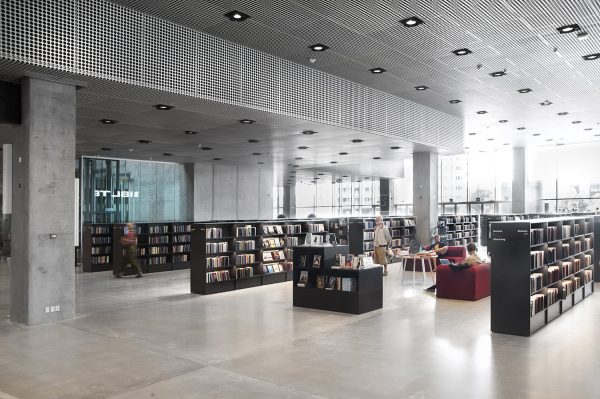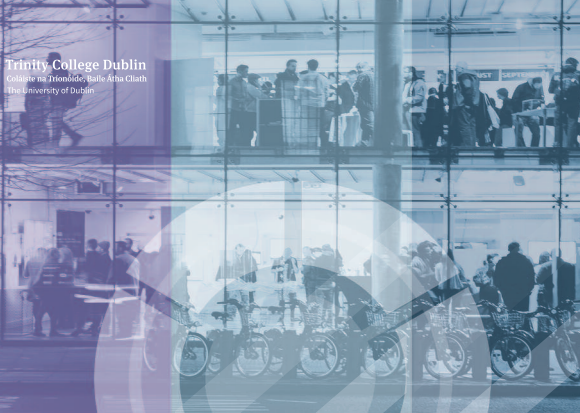The ‘open’ or ‘staffless’ library has completed its pilot stage and is now being rolled out in many libraries across the country. Yet, anger still rages amongst librarians who feel they are being viewed as obsolete, as well as the public who fear libraries will become soulless repositories. Do we have a right to be concerned or should we learn to stop worrying and love the open library?
‘Crazy’, ‘idiotic’ and ‘half-formed’; these were the words used by Mary O’Rourke in her open letter to Minister for Local Government, Simon Coveney, regarding the proposal to introduce ‘staffless’ libraries. Like many contentious issues, one of the first disagreements is what the new library system should be called. Officially, the initiative to use automation to extend the opening hours of libraries beyond regular staff hours is called ‘Open Library’. From the other position, the title ‘Staffless’ has become the nomenclature of choice.
The move to introduce open (or ‘staffless’) library hours is an extension of a pilot scheme in Tullamore, Banagher and Tubbercurry. The entire cost of the scheme is estimated to be about €1.94 million; the department will pay €1.41 million and the libraries will provide the other €500,000. The initiative will see 22 public libraries around the country remain open after regular staff hours, so that that the public will have access to the facilities from 8am-10pm.
The argument against open libraries, particularly from the librarians’ perspective is a very legitimate one. Since 2008 the service has suffered a 20% reduction in staff. Some libraries around the country, such as the main library in Sligo town, stand temporarily closed due to staff shortages caused by the Government’s demand for a 42% reduction in council staff. The idea that money is now being spent on making libraries operation without staff rather than paying librarians themselves must look very much like the beginning of the end for librarians.
However, the trouble with this criticism is that it equates a necessary service update with a fundamental overhaul of the entire library system. The argument presupposes that the open library is just a first step in what will eventually become complete removal of all library staff, to be replaced instead by automation. From outside observers of the issue, such as Mary O’Rourke, the argument against open libraries hinges on a sentimental and nostalgic view of what the library should be, ignoring the enormous social and technological changes that have taken place during the past quarter century.
So, what is an open library? It is important to understand what services the open library provides before any argument can be made for or against it. Indeed, it is important to have a holistic understanding of what a library is before we can say whether not it should change.
What is an ‘Open Library’?
My Open Library extends the availability of library services during unstaffed hours while continuing to provide the regular staffed hours for ongoing delivery of the service and supporting users. During My Open Library hours, the service is operated on a self-service basis to library members aged 16 and over for borrowing and returning items, using the internet via library PCs or via Wi-Fi using their own devices, browsing, printing, photocopying, individual study or community activities and meetings. Library users gain access to the library via an automated system by using their membership card and an authorised pin number. Children can use the service if accompanied by a registered adult member. Entrance control software and new security provisions are installed in the branches, along with enhanced monitoring, lighting and public address systems.
Open library services have been operating very successfully for almost two years in Banagher Library, Co Offaly and Tullamore Library, Co. Offaly, and Tubbercurry Community Library, Co. Sligo. Feedback from members of the public has been extremely positive, with users commenting that the library is now much more accessible for commuters, students and families. Library staff in these three branches also report very encouraging experiences with their Open Library. With an increase in opening hours of up to 85%, the new services have been found to strengthen the prominence of the library in the local community by providing a town’s only non-commercial, indoor meeting place, welcoming to all and open daily from early morning to late evening. Open Library has brought significantly increased usage of these libraries, particularly at weekends, and is attracting a broader range of customers with considerably increased use from the 35–55 year old group in the evenings. The number of items being borrowed from these libraries has also increased.
A Long Legacy
Despite the benefits of the Open Library, one might still be inclined to question any technologically driven changes to such a highly established and beloved institution. More so than any other institution, the library stands as a symbol for our collective cultural heritage. With the first known collection of recorded knowledge found in ancient Mesopotamia over 5,000 years ago, libraries have been around for almost as long as civilisation itself. It isn’t any wonder then that people are hesitant to see new changes implemented. Why change something that has worked just fine for so long?
The historic context is very important here. It is certainly true that libraries, since their inception, have been a beacon of human erudition and accomplishment. To remove the staff is to remove some of the humanity that resides within them. However, there is also a strong historical argument for change. In ancient times libraries were the reserve of the elite; out of bounds for the poverty stricken or uneducated. When Rome opened their public libraries, which were open to the masses, rich and poor, they were located in the imperial baths, where people would bathe, play ball and read. The point is that although libraries have always been a fixture of societies they have never been a static one. As societies change, so do their libraries.
Back in the early 2000s, when the ebook was coming into prominence, there was a similar outcry. People rejected the idea that new digital technology could replace the tradition book. To them, the ebook lacked the old world charm and comfort of the paper book. It was a technology where technology was not needed. Yet, here too we can site an evolution, from clay tablets and papyrus scrolls to incunabulums and the modern day paperback. Furthermore, what we discovered with the ebook is that it never replaced the traditional book; it simply became a useful supplement.
Public libraries, if they to remain relevant, must adapt to the needs of the public. Right now we are seeing seismic changes in how people work and approach education. The internet allows people to work from anywhere at any time of day but they still require a physical place to base themselves. For many, using the home as a workplace is not an option, nor are cafés a viable solution as they require patronage and only open during business hours. The library presents a unique solution to mobile workers and people undertaking online courses, but only if they are adaptive to their needs. Opening up the library as a dynamic, multi-functional, and time-flexible public space is a natural evolutionary progression.
As new forms of books become available so too will new forms of libraries. This does not mean that their legacy will be fundamentally changed. Longer opening hours, even if unstaffed, will not make staff redundant. The librarian will remain as important as ever to the new structure. Take, for example, university libraries: students have been using what are essentially open library systems for years. It is common practice on campuses across the country for libraries to remain open late into the night, outside of staff hours. This allows students increased access to educational resources as well as a quiet, facilitated environment where they can do their work without distraction. Far from being a threat to what libraries represents, open libraries are a closer realisation of what these public spaces were built to be.
The Third Place
A ‘third place’ is defined as a place where you feel at home, but which is not your place of work/study or your own home. The library should be this kind of place: a safe place to meet and hang out. To accommodate this function, the library needs to change its use of space, routines and ways in which people are received.
The physical changes to the library are important, but changes to the ways in which the library operates may be even more so. A large part of staffing resources remains tied up in manual routines associated with physical media and the reception desk. Modern library operations entail acknowledging active dissemination and work with events as important and necessary tasks.
The number of manual routines needs to be reduced, and the users must be able to use self-service functions to the greatest extent possible. Placing physical and digital services on an equal footing is also essential.
In the ‘third place’ the librarian will play an essential new role. They will be there to inspire, enlighten and challenge. The task of librarian’s will be to explore new ways to identify the most relevant parts of the collection to disseminate and make it available to the users in new and more varied ways. The old approach that requires all books to be presented systematically and as a whole will soon change.
For instance, the librarian may choose to pick fiction published during the last two years and combine it with relevant non-fiction to produce new and surprising perspectives. Other new roles will include transferring materials to the digital network and duties related to new school curriculums. Those who wish for and need help will of course be provided with it, but only during staffed hours.
The Scandinavian Example
In recent decades, libraries have increasingly sought opportunities to automate their processes. Self-issue machines, Google-style discovery systems and remote access to digital resources mean that the role of library staff in supporting access and use has undergone fundamental change. In general, librarians have tended to embrace technological developments and have resisted any fears of the Ned Ludd variety by seeking to upskill themselves. However, with ‘staffless’ libraries there has been more trepidation.
Faced with the familiar pressure of maintaining public library services on reduced budgets, Danish politicians trialled ‘staffless’ or ‘open’ libraries, defined as branches where a proportion of opening hours are un-staffed by paid professionals (volunteers present did not count as staffed). With the 25 libraries involved able to open longer without additional staffing costs, community access to the physical library building, book stock, computers and meeting rooms was increased, resulting in 23% more visits by library users and 14 branches reporting increased borrowing of material. The concept proved particularly popular with younger users, with around a third of visitors aged below 35. Remarkably, and perhaps due to Denmark’s relatively high level of social capital, vandalism to staffless libraries was minimal, with the handful of reports falling far short of predictions.
However, it was also noted that the higher visitor numbers reported were ‘not sensational’ when opening hours were increased up to 300%. And crucially, there were no cases where the number of visitors per hour during unstaffed hours surpassed the number of visits when staff were present. On average, there were four visits per hour when libraries were unstaffed, compared to 29 visits per staffed hour. People also borrowed more books when staff were present. This pattern indicates that the presence of staff still is a factor influencing public library performance. It seems that, given a choice, people prefer to use libraries staffed by professionals.
Additional research further emphasises the importance of library staff, with mystery shopper data suggesting that knowledge, competence, friendliness and positive attitudes of library staff can significantly add value to the library user’s experience. Proactive approaches to customer support, including making suggestions and recommendations, and ‘floor walking’ were highly valued. Regardless of the ‘open’ or ‘staffless’ system it seems that supportive, welcoming, innovative and skilled library staff are as highly valued today as they have been in the past. One of the most intriguing facts to come out of a National survey in Denmark is that if you only have self-service hours and not staffed hours the use of the library declines. ‘Staffless’ libraries are here to stay but so are the staff.













